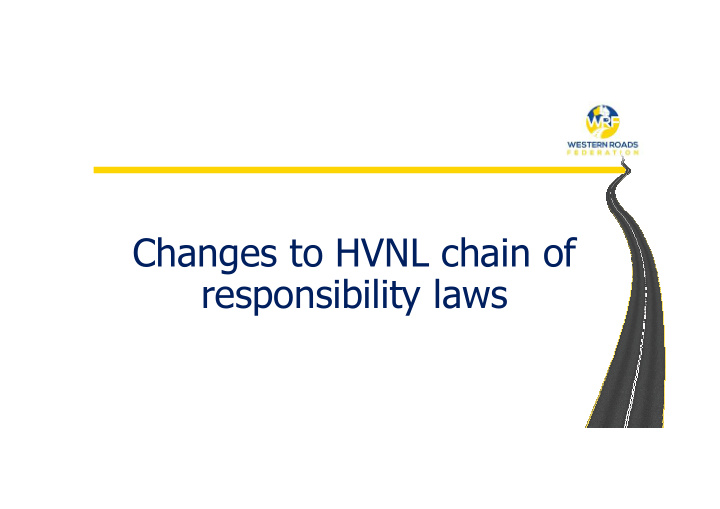



Changes to HVNL chain of responsibility laws
Safety duties • The safety of transport activities relating to a heavy vehicle is the shared responsibility of each party in the Chain of Responsibility for the vehicle. • The responsibility depends on the function the person performs, the nature of the risk and the person’s capacity to control, eliminate or minimise the risk. Our members DRIVE the WA Economy 2
Primary duty Each party in the Chain of Responsibility (CoR) must ensure, so far as is reasonably practicable, the safety of their transport activities. Employer Prime Contractor Operator Scheduler Consignor Consignee Packer Loading Manager Loader Unloader Our members DRIVE the WA Economy 3
Primary duty Each party must, so far as is reasonably practicable: � eliminate or minimise public risks � not cause or encourage a driver of a heavy vehicle or another person to contravene this Law Our members DRIVE the WA Economy 4
Pri rimary ry Duty - So far as is reasonably practicable What is the What is the What should What are Are the costs degree of likelihood of you know the ways proportionate harm that the risk about the to remove to the risk? could be occurring? risk? the risk? caused? Likelihood Harm Kno nowledge Solutions Cost
Duty of executive of legal entity Executives of legal entities must exercise due diligence to ensure the safety of the legal entity’s transport activities. • An executive means: For a corporation – an executive officer • For an unincorporated partnership – a partner • For an unincorporated body – a management • member Our Members DRIVE the WA Economy 6
Due Diligence for executives • Gain and maintain knowledge about safe conduct of your transport activities • Understand the hazards and risks associated with your transport activities • Have appropriate resources to implement processes to eliminate or minimise your hazards and risks • Respond to information received about your hazards and risks in a timely manner • Verify that your resources and processes are provided, used and implemented Our members DRIVE the WA Economy
Prohibited requests and contracts A person must not enter into contracts or arrangements that encourage, reward or give incentives to the driver or other parties in the supply chain to breach the law. Our members DRIVE the WA Economy 8
Benefits of Alignment of HVNL with WHS laws • Common Systems - Manage safety risks across the entire business with same systems/practices • Integration - Create safety synergies across parties in the CoR with common approaches and strategies • Economy - Reduce costs by using the same processes and similar practices Our members DRIVE the WA Economy 9
WA Comparison with HVNL : What is applicable? WA Law HVNL � � Applies to vehicles exceeding 4.5 tonnes GVM � � Applies to vehicles under 4.5 tonnes GVM (Light Vehicles) � � Mass, dimension and load restraint offences � � Speed offences � � Fatigue offences � � Container Weight Declarations (CWD)
Industry Codes of Practice • Establishes standards Master and procedures for Code parties in the chain of responsibility to identify, analyse, evaluate and Crane Forestry Livestock mitigate general risks associated with meeting obligations under the Heavy Vehicle National Law (HVNL). Our members DRIVE the WA Economy
Questions • Should WA consider the alignment of our CoR with WHS? • Should we consider developing a WA Code of Practice? • Should mandatory accreditation be expanded? Our members DRIVE the WA Economy
Recommend
More recommend